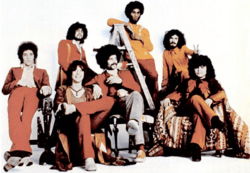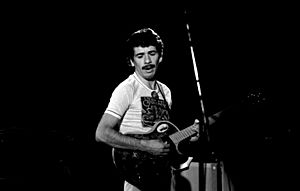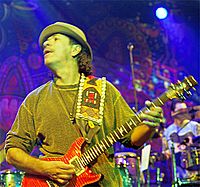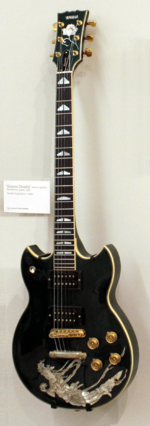Carlos Santana facts for kids
Quick facts for kids
Carlos Santana
|
|
|---|---|
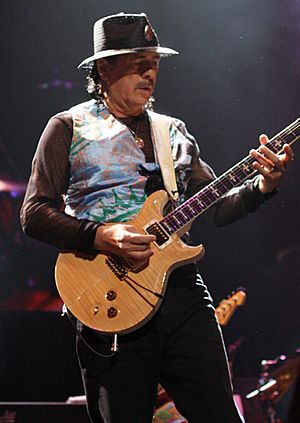
Santana performing in 2011
|
|
| Background information | |
| Birth name | Carlos Humberto Santana Barragán |
| Born | July 20, 1947 Autlán de Navarro, Jalisco, Mexico |
| Origin | San Francisco, California, U.S. |
| Genres | |
| Occupation(s) |
|
| Instruments |
|
| Years active | 1965–present[update] |
| Labels | |
Carlos Humberto Santana Barragán (born July 20, 1947) is a famous American guitarist. He is best known for starting the rock band Santana. Born in Mexico, he moved to the United States and became famous in the late 1960s.
Santana helped create a new style of music that mixed rock and roll with Latin American jazz. His band's sound was unique. It featured his smooth, blues-inspired guitar playing mixed with Latin and African beats. The band used percussion instruments like timbales and congas, which were not common in rock music at the time. After a quiet period, he became very popular again in the late 1990s.
In 2023, Rolling Stone magazine named him the 11th greatest guitarist of all time. He has won 10 Grammy Awards and three Latin Grammy Awards. In 1998, he and his band were welcomed into the Rock and Roll Hall of Fame.
Contents
The Story of a Guitar Legend
A Musical Kid from Mexico
Carlos Santana was born in Autlán, Mexico, on July 20, 1947. His father was a mariachi musician who taught him to play the violin at age five and the guitar at age eight. His younger brother, Jorge, also became a professional guitarist.
When Carlos was a boy, his family moved to Tijuana, a city on the border with the U.S. He was inspired by early rock and roll and blues artists like B.B. King and Chuck Berry. Later, his family moved to San Francisco, California. In 1966, Carlos started a group called the Santana Blues Band.
The band began to mix many different styles of music. Santana said it was like being at a university. In one room, he would hear Sly Stone and Jimi Hendrix. In another, he would hear The Rolling Stones or the Beatles. He also listened to Latin music stars like Tito Puente and jazz legends like Miles Davis. All these sounds helped shape his unique style.
Breakthrough at Woodstock
The band, now just called "Santana", signed a record deal with Columbia Records. Before their first album was even released, they got a huge opportunity. The famous promoter Bill Graham arranged for them to play at the Woodstock Music and Art Festival in 1969.
Their performance was a huge surprise and a massive hit. Their exciting 11-minute instrumental song, "Soul Sacrifice", amazed the crowd. When the Woodstock movie and soundtrack came out, the band became famous all over the world. Their first album, Santana, was released in August 1969 and became a bestseller.
Success in the 1970s
The band's second album, Abraxas (1970), was even more successful. It mixed rock, blues, jazz, and salsa. The album included two of Santana's most famous songs: "Oye Como Va" and "Black Magic Woman". Abraxas was number one on the Billboard chart for six weeks.
In 1971, a talented teenage guitarist named Neal Schon joined the band. This gave their third album, Santana III, a powerful sound with two lead guitars. It was another number one album.
However, the band members began to have disagreements. Santana wanted to explore more jazz-like music, while others wanted to stick to hard rock. These differences led to several members, including Schon and singer Gregg Rolie, leaving the band. They later formed the band Journey.
Exploring New Sounds
In 1972, Santana released the album Caravanserai. It had a strong jazz fusion style, which was a big change. While some critics loved it, it was not as popular with all of his fans.
During this time, Santana became very interested in spirituality. He and guitarist John McLaughlin recorded an album together called Love, Devotion, Surrender in 1973.
Throughout the 1970s, Santana continued to change his band's lineup and experiment with different styles. The 1976 album Amigos brought back some of the Latin-funk sound his fans loved. It included the hit instrumental "Europa (Earth's Cry Heaven's Smile)". Another big hit from this time was his version of "She's Not There" from the 1977 album Moonflower.
A Return to the Top
After a few quieter years, Santana made a huge comeback in 1999. He worked with producer Clive Davis to create the album Supernatural. The album featured collaborations with many popular younger artists.
The first single, "Smooth", featured Rob Thomas from the band Matchbox Twenty. The song was a massive success. It spent 12 weeks at number one on the Billboard Hot 100 chart. The next single, "Maria Maria", also went to number one.
Supernatural became Santana's most successful album. It sold over 15 million copies in the U.S. and won eight Grammy Awards, including Album of the Year.
Following this success, Santana released more albums with guest artists. The 2002 album Shaman included the hit song "The Game of Love" with singer Michelle Branch.
Recent Years and Legacy
Santana has continued to tour and record music. In 2014, he released his first Spanish-language album, Corazón. In 2016, he reunited with the classic lineup of his band from the early 1970s to record the album Santana IV.
He has worked with many other artists, including the Isley Brothers, Shakira, and Michael Jackson. He continues to be an inspiration to musicians of all ages.
In December 2018, Santana even created an online guitar lesson for the MasterClass series, sharing his skills with the world. His most recent studio album, Blessings and Miracles, was released in 2021. In March 2025, a compilation album titled Sentient was released, featuring his past collaborations and new tracks.
Personal Life
Santana became a U.S. citizen in 1965. He was married to Deborah King from 1973 to 2007, and they have three children: Salvador, Stella, and Angelica. Together, they started the Milagro Foundation, a charity that helps children with education and healthcare.
In 2010, Santana married Cindy Blackman, who is a talented drummer and has toured with his band. They currently live in Las Vegas.
In July 2022, Santana collapsed on stage during a concert from heat and dehydration. He recovered quickly and, after a short break, returned to performing.
Guitars and Sound
Santana is known for his unique guitar tone. He has played many guitars over his career, including a red Gibson SG Special at Woodstock.
Since the 1980s, he has mostly used custom-made PRS guitars. The company even created a Santana signature model. He plugs his guitars into multiple amplifiers, including Mesa Boogie and Dumble amps, to create his rich, singing sound. He once said a Mesa Boogie amp "really Boogies!", which helped give the company its name.
Awards and Honors
- Grammy Awards: He has won 10 Grammy Awards, including a 1988 award for his solo album Blues for Salvador.
- Latin Grammy Awards: He has won 3 Latin Grammy Awards.
- Rock and Roll Hall of Fame: Inducted in 1998.
- Billboard Century Award: Received in 1995 for his career achievements.
- Kennedy Center Honors: Honored in 2013 for his contributions to American culture.
Studio Albums
This is a list of his major solo albums, not including albums with the band Santana.
- Love Devotion Surrender (1973)
- Illuminations (1974)
- Oneness – Silver Dreams Golden Reality (1979)
- The Swing of Delight (1980)
- Havana Moon (1983)
- Blues for Salvador (1987)
- Santana Brothers (1993)
Images for kids
-
Santana in Barcelona, Spain, 1984


